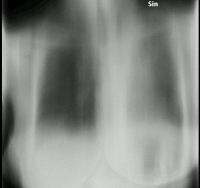
Photo from wikipedia
Aspergillus is a mold that may lead to different clinical pictures, from allergic to invasive disease, depending on the patient’s immune status and structural lung diseases. Chronic pulmonary aspergillosis is… Click to show full abstract
Aspergillus is a mold that may lead to different clinical pictures, from allergic to invasive disease, depending on the patient’s immune status and structural lung diseases. Chronic pulmonary aspergillosis is an infection with a locally invasive presentation, reported especially in patients with chronic pulmonary disease, while aspergilloma is typically found in patients with previously formed cavities in the lungs. Allergic bronchopulmonary aspergillosis is due to a hypersensitivity reaction to Aspergillus antigens and is more frequently described in patients with moderate-severe asthma or cystic fibrosis. Invasive pulmonary aspergillosis mainly occurs in patients with neutropenia or immunodeficiency, but has increasingly been recognized as an emerging disease of non-neutropenic patients. The significance of this infection has dramatically increased in recent years, considering the high number of patients with an impaired immune state associated with the management and treatment of neoplasm, solid or hematological transplantation, autoimmune diseases, and inflammatory conditions. Moreover, prolonged steroid treatment is recognized as an important risk factor, especially for invasive disease. In this setting, critically ill patients admitted to intensive care units and/or with chronic obstructive pulmonary disease could be at higher risk for invasive infection. This review provides an update on the clinical features and risk factors of pulmonary aspergillosis. Current approaches for the diagnosis, management, and treatment of these different forms of pulmonary aspergillosis are discussed.
Journal Title: Infectious Diseases and Therapy
Year Published: 2020
Link to full text (if available)
Share on Social Media: Sign Up to like & get
recommendations!